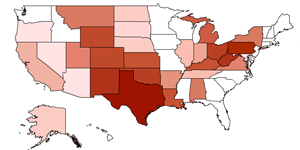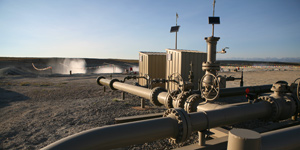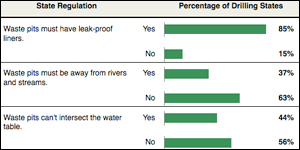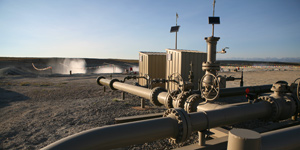This story was written by ProPublica’s Adam Lustgarten.
The two key arguments that the oil and gas industry is using to fight federal regulation of the natural gas drilling process called hydraulic fracturing — that the costs would cripple their business and that state regulations are already strong — are challenged by the same data and reports the industry is using to bolster its position.
One widely-referenced study (PDF) estimated that complying with regulations would cost the oil and gas industry more than $100,000 per gas well. But the figures are based on 10-year-old estimates and list expensive procedures that aren’t mentioned in the proposed regulations.
Another report (PDF) concluded that state regulations for drilling, including fracturing, “are adequately designed to directly protect water.” But the report reveals that only four states require regulatory approval before hydraulic fracturing begins. It also outlines how requirements for encasing wells in cement — a practice the author has said is critical to containing hydraulic fracturing fluids and protecting water — varies from state to state.
One recommendation in that report flies in face of industry’s assertion that its processes are safe: hydraulic fracturing needs more study and should be banned in certain cases near sensitive water supplies.
Hydraulic fracturing — where water and sand laced with chemicals is injected underground to break up rock — is considered essential to harvesting deeply buried gas reserves that some predict could meet U.S. demand for 116 years.
In 2005 hydraulic fracturing was exempted from the Safe Drinking Water Act, based on assurances that the process was safe. But a series of ProPublica reports has identified a number of cases in which water has been contaminated in drilling areas across the country, and EPA scientists say they can’t fully investigate them because of the exemption.
Now, Congress is considering legislation to restore the Environmental Protection Agency’s oversight of the process. And industry — leveraging its money and political connections — is using the recent reports to fight back.
Since January at least five studies have been published making the case that state laws (PDF) are adequate and that new regulations could hamper exploration (PDF), raise fuel prices and eliminate jobs. Three of the studies were paid for by the Department of Energy and produced by consulting firms that also work with the industry. One of the DOE reports (PDF) was written by the same person who authored a study for the Independent Petroleum Association of America (PDF)
The industry argues (PDF) that federal oversight would amount to a redundant layer of bureaucracy that is not needed because states already require the same environmental safeguards that might be required by the EPA, and that those safeguards are effective.
“We don’t think the system is broke, so we question the value of trying to fix it with a federal solution,” Richard Ranger, a senior policy analyst at the American Petroleum Institute, told ProPublica in May. “So proceed with caution if you are going to proceed with regulating this business because it could make a very significant difference in delivering a fuel that is fundamental to economic health.”
 How Many Natural Gas Wells Does Your State Have?ProPublicaIndustry reports say that if federal regulations are applied to hydraulic fracturing, more than a third of onshore gas wells would be closed and oil and gas companies would spend $10 billion complying with the law in its first year. The federal government would lose some $1.2 billion in revenue.
How Many Natural Gas Wells Does Your State Have?ProPublicaIndustry reports say that if federal regulations are applied to hydraulic fracturing, more than a third of onshore gas wells would be closed and oil and gas companies would spend $10 billion complying with the law in its first year. The federal government would lose some $1.2 billion in revenue.
But advocates for the federal legislation say the industry is misleading the public into a false choice between the economy and the environment.
“We are all for using science-based information,” said Amy Mall, a senior policy analyst for the Natural Resources Defense Council. “But the underlying information doesn’t really tell the story they claim it does.”
Nonetheless, the arguments have gained traction in Congress and have eroded support for new regulation.
Rep. Dan Boren, D-Okla., told his fellow members in a recent hearing that “these folks are laying people off — people are hurting in my district.” Rep. John Salazar, D-Colo., who sponsored legislation to regulate fracturing in 2008, but declined to add his name to this year’s bill, told ProPublica that “developers may have legitimate concerns about the impact that removing the exemption may have on their ability to find and extract oil and gas.”
To keep the legislation alive, Diana DeGette, D-Colo., its main sponsor, has shifted gears to seek environmental studies and hearings rather than a quick passage into law.
“The opposition has been throwing out scare tactics and mischaracterizations of what she is trying to do,” said DeGette’s spokesman, Kristofer Eisenla. “Unfortunately the oil and gas guys came out of the barn storming.”
Fuzzy Numbers
The study that has received the most publicity (PDF) is also among the most misleading.
The report, which evaluates the costs of regulations for the oil and gas industry, was written for the Department of Energy by a consulting company also used by the energy industry, Advanced Resources International, or ARI. It contains a table (PDF) listing seven specific processes it says would be mandated under the proposed federal regulations, and what those processes would cost — a total of $100,505 per well. Among the listed items is “state of the art” fracture imaging, at a per-well average cost of $37,500, and three-dimensional fracture simulation, at a cost of $7,500.
But a footnote reveals that these figures are based on memo sent to a DOE official by another consulting firm in 1999. The report’s author said they haven’t been updated to reflect technological advances or substantial shifts in the drilling business over the last decade.
Furthermore, none of the tests listed in the table are mentioned in the text of Safe Drinking Water Act, the federal law that would apply to hydraulic fracturing, according to an EPA spokesperson in Washington. And they aren’t mentioned in the bill being floated in Congress either.
“It’s a sense of magnitude of the impacts, not a sense of absolute accuracy,” said Michael Godec, Vice President of ARI and author of the report. The regulatory requirements were interpolated on a “bad-case” scenario, he explained, because the federal laws are not specific. “We took some liberties. You have to make some assumptions about what might be required.”
 One of the industry reports raises serious questions about the construction of the pits used to store toxic drilling waste and what happens when dangerous fluids are spilled.ProPublicaGodec believes that many of the processes listed in the report are already being practiced to a greater degree than they were in 1999, meaning that even if they were required they may not be additional burdens at all. But he said that anecdotal conversations with drilling companies confirm that the report’s conclusions are still “about right.”
One of the industry reports raises serious questions about the construction of the pits used to store toxic drilling waste and what happens when dangerous fluids are spilled.ProPublicaGodec believes that many of the processes listed in the report are already being practiced to a greater degree than they were in 1999, meaning that even if they were required they may not be additional burdens at all. But he said that anecdotal conversations with drilling companies confirm that the report’s conclusions are still “about right.”
Godec said he did not obtain recent cost figures from drilling companies, which are closely guarded. Halliburton — one of the largest hydraulic fracturing service providers — did not return calls from ProPublica for comment about the expense of the procedures listed.
Asked whether the age of the data was a concern, Godec said it had been discussed with Nancy Johnson, the DOE official who commissioned the report. He said he was instructed that the report was needed quickly, that the budget was limited and that he should move forward because “this is a hot topic and people are testifying.”
Nancy Johnson did not return calls for comment and the Department of Energy’s office of fossil energy did not make its officials available for an interview after repeated requests. It said, through a spokesperson, that the Department did not author the report.
Godec also produced a similar report on costs and state gas regulations for the Independent Petroleum Association of America that was published in late April. Titled “Bringing Real Information on Energy Forward,” (PDF) that report also makes the case that state regulations of drilling practices are effective. Godec says his company’s work is impartial and his conclusions would have been the same whether he was contracted by the oil and gas industry, or the federal government.
Even if the costs Godec laid out in the DOE report were up-to-date and accurate, it’s doubtful they would have the devastating financial impact the industry claims.
The estimated expense of regulating hydraulic fracturing amounts to between one and three percent of the total cost of drilling a new well when factored into operating costs estimated by financial analysts at Deutsche Bank. If all the testing that Godec includes is factored out, the regulations would cost the industry just $4,500 per well, according to his report, or just six hundredths of a percent of the cost of establishing a typical new well.
“I think at the end of the day it’s unlikely to have a real huge impact,”says John Freeman, a senior vice president for energy equity research at the investment bank Raymond James. “It’s a lot of fuzzy stuff that I can’t get my hands around. This just seems to be more of a soft number that I frankly have more of a hard time connecting the dots on.”
State Regulations Leave Gaps
In May the Ground Water Protection Council, a group made up mostly of industry representatives and state oil and gas regulators, released the first comprehensive review (PDF) of oil and gas regulations across 27 of 31 drilling states it surveyed. The report, paid for by the DOE, concluded that most states have requirements to encase wells in cement and protect groundwater, and that a majority also require they be notified after hydraulic fracturing takes place.
“The study confirms what the industry has been saying (PDF): that regulation of oil and gas field activities, including hydraulic fracturing, is best accomplished at the state level,” the American Petroleum Institute said a press release about the study.
But the GWPC report — which focuses on what regulations are in place, rather than what may be missing — raises important points that are downplayed in its summary. It reveals that regulatory oversight is inconsistent from state to state and has substantial gaps. It also says hydraulic fracturing requires “comprehensive” further study “to determine the relative risk” and to determine best practices.
In fact, the report calls for some of same measures found in the congressional bill the industry is so hotly contesting.
 See Where States Fall on Oil and Gas RegulationProPublicaRegarding fracturing in areas close to the surface or near shallow aquifers, the report reads: “States should consider requiring companies to submit a list of additives used in formation fracturing and their concentration.” It also says that shallow fracturing very close to certain drinking water aquifers “should either be stopped, or restricted to the use of materials that do not pose a risk of endangering ground water and do not have the potential to cause human health effects.”
See Where States Fall on Oil and Gas RegulationProPublicaRegarding fracturing in areas close to the surface or near shallow aquifers, the report reads: “States should consider requiring companies to submit a list of additives used in formation fracturing and their concentration.” It also says that shallow fracturing very close to certain drinking water aquifers “should either be stopped, or restricted to the use of materials that do not pose a risk of endangering ground water and do not have the potential to cause human health effects.”
A close examination of the appendices (PDF) attached to the research also showed that 21 of the 31 states listed do not have any specific regulation addressing hydraulic fracturing; 17 states do not require companies to list the chemicals they put in the ground; and no state requires companies to track how much drilling fluid they pump into or remove from the earth — crucial data for determining what portion of chemicals has been discarded underground.
“The tone is that in general states do an adequate job of protecting water,” said Michael Nickolaus, the report’s author, special projects director for the GWPC and former director of Indiana’s state Oil and Gas Division. “There are certain gaps in certain states … it’s not a hundred percent world.”
The GWPC report does not name the states that lack more stringent regulations, a detail that is important because one or two states can account for a large proportion of the drilling in the United States. To extract that information from the report would require analyzing all the state regulations included in the appendices (PDF) and repeating much of the GWPC’s original research. Nickolaus also declined to name the states in an interview with ProPublica, saying that the GWPC was obliged to protect its members.
Nickolaus says well construction — especially the cementing process that keeps drilling fluids and gas from seeping into groundwater — is more important than the fracturing issue. But according to the report, state regulations about cementing are sometimes vague and often don’t specify standards that makes the protection fool-proof.
While most states have regulations that protect drinking water near the surface, a third don’t require that the cement casing extends far enough to completely isolate wells from geologic layers and the deepest aquifers, according to the report. Twenty-two percent don’t require the cement to harden before the well is used for fracturing, and don’t test cement quality and consistency — one of the surest ways to protect against contamination.
Reprinted courtesy ProPublica.org.



